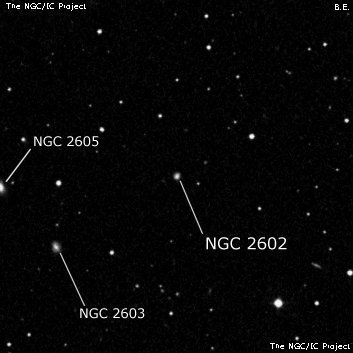
John Herschel discovered NGC 2602 = h508 on 16 Feb 1831 (sweep 327). His mean position from two observations is 08 35 01.4 +52 50 10 (2000), an excellent match with CGCG 263-056. His description from the next night reads "eF; S; R; north-preceding a star (about 5° n p). The preceding neb of 2 [with NGC 2606]. A mag 10.8 star 2.5' ENE is probably the intended star, so the description should read "south-preceding a star". MCG and PGC correctly identify NGC 2602.
The field was observed three times at Birr Castle. On the first observation (9 Feb 1850), the three brightest galaxies -- NGC 2600, 2602 and 2606 -- were likely observed. On a second observation by R.J. Mitchell on 11 Mar 1858, 4 nebulae were described and sketched. Harold Corwin suggests the following identifications: "4 neb. found, alpha [NGC 2603] is F, S, bM; beta [NGC 2605] is vvF, gamma [NGC 2602] F, S, lbM; delta NGC 2606] is E and has a Nucl, a F * sf. alpha and gamma are about 5 arcmin dist. from one another, and beta and delta about the same dist. apart."
In compiling the GC, it appears that JH assumed alpha was h508 = NGC 2602, the preceding nebula in the sketch. So, he misplaced the two LdR novae --[NGC 2603 and[NGC 2605 -- following, instead of preceding NGC 2602. In addition, on the third observation (5 Mar 1867), Sir Robert Ball noted "2 neb seen nearly p f, p one eeF, f one NGC 2606] eF. Measures extremely difficult. Pos 92°, Dist 118°." The preceding nebula is PGC 2423840, but it didn't receive a NGC designation. See Harold Corwin's identification notes under NGC 2600.
400/500mm - 17.5" (3/12/94): extremely faint and small, 15" diameter, possibly elongated. Located 2.6' WSW of a mag 10.5 star. Forms a pair with brighter NGC 2606 5.2' SE.
Notes by Steve Gottlieb